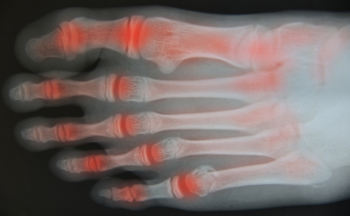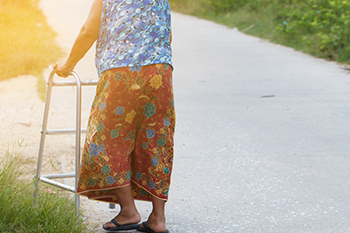Call Us Today! (203) 975-9600
SAME DAY APPOINTMENTS AVAILABLE
February 2022
How Walking Can Affect Falls in Older People
Hardly anyone thinks about how to walk. After all, we’ve been doing it for years. However, it turns out that ankle flexion, which is one of the components of each step you take, can decrease with age. This loss means taking a shorter stride, landing with flat feet, and putting more space between the feet as you walk. The result is a side-to-side motion that could affect your balance and put you at risk of falling. And rather than transferring the weight from one foot to the other with each step, you end up performing more of a shuffle. This also forces you to look down as you walk, putting your body out of alignment and increasing the risk. An easy solution is to exercise your ankles as often as possible, while watching TV or anytime you are resting. Just push your ankle up and down several times on each foot. Another exercise is the heel press, which stretches the calf muscles and improves flexion of the ankles. Before undertaking any new exercise regime, it is a good idea to seek the advice of a podiatrist who can measure your ankle flexion and monitor your activity.
Preventing falls among the elderly is very important. If you are older and have fallen or fear that you are prone to falling, consult with one of our podiatrists from Preferred Footcare, LLC. Our doctors will assess your condition and provide you with quality advice and care.
Every 11 seconds, an elderly American is being treated in an emergency room for a fall related injury. Falls are the leading cause of head and hip injuries for those 65 and older. Due to decreases in strength, balance, senses, and lack of awareness, elderly persons are very susceptible to falling. Thankfully, there are a number of things older persons can do to prevent falls.
How to Prevent Falls
Some effective methods that older persons can do to prevent falls include:
- Enrolling in strength and balance exercise program to increase balance and strength
- Periodically having your sight and hearing checked
- Discuss any medications you have with a doctor to see if it increases the risk of falling
- Clearing the house of falling hazards and installing devices like grab bars and railings
- Utilizing a walker or cane
- Wearing shoes that provide good support and cushioning
- Talking to family members about falling and increasing awareness
Falling can be a traumatic and embarrassing experience for elderly persons; this can make them less willing to leave the house, and less willing to talk to someone about their fears of falling. Doing such things, however, will increase the likelihood of tripping or losing one’s balance. Knowing the causes of falling and how to prevent them is the best way to mitigate the risk of serious injury.
If you have any questions, please feel free to contact our office located in Stamford, CT . We offer the newest diagnostic and treatment technologies for all your foot care needs.
Reminder: When Was the Last Time...?
Eight Symptoms of Toe Arthritis
 You may be familiar with aching joints in the hands and fingers, but have you ever heard of arthritis in the toes? This problem is surprisingly common, particularly among older people, who often have osteoarthritis, and people of all ages with rheumatoid or psoriatic arthritis. The most common symptom of arthritis in the toes is toe pain, which can range from a deep ache to a sharp or stabbing sensation. As their cartilage lining is damaged and wears away, the joints can become stiff and difficult to move. Swelling is also a common symptom. While walking, the toe joints may make a clicking, popping, or grinding sound, like the sound of cracking your knuckles. The toes may also become deformed over time and feel warm or hot because of inflammation. When joint damage is extensive and severe, the joint can become locked in place. All these symptoms combined can make walking, or even standing, difficult. If you have arthritis in your feet, a podiatrist can help you manage the symptoms and maintain your mobility.
You may be familiar with aching joints in the hands and fingers, but have you ever heard of arthritis in the toes? This problem is surprisingly common, particularly among older people, who often have osteoarthritis, and people of all ages with rheumatoid or psoriatic arthritis. The most common symptom of arthritis in the toes is toe pain, which can range from a deep ache to a sharp or stabbing sensation. As their cartilage lining is damaged and wears away, the joints can become stiff and difficult to move. Swelling is also a common symptom. While walking, the toe joints may make a clicking, popping, or grinding sound, like the sound of cracking your knuckles. The toes may also become deformed over time and feel warm or hot because of inflammation. When joint damage is extensive and severe, the joint can become locked in place. All these symptoms combined can make walking, or even standing, difficult. If you have arthritis in your feet, a podiatrist can help you manage the symptoms and maintain your mobility.
Arthritis can be a difficult condition to live with. If you are seeking treatment, contact one of our podiatrists from Preferred Footcare, LLC. Our doctors can provide the care you need to keep you pain-free and on your feet.
Arthritic Foot Care
Arthritis is a term that is commonly used to describe joint pain. The condition itself can occur to anyone of any age, race, or gender, and there are over 100 types of it. Nevertheless, arthritis is more commonly found in women compared to men, and it is also more prevalent in those who are overweight. The causes of arthritis vary depending on which type of arthritis you have. Osteoarthritis for example, is often caused by injury, while rheumatoid arthritis is caused by a misdirected immune system.
Symptoms
- Swelling
- Pain
- Stiffness
- Decreased Range of Motion
Arthritic symptoms range in severity, and they may come and go. Some symptoms stay the same for several years but could potentially get worse with time. Severe cases of arthritis can prevent its sufferers from performing daily activities and make walking difficult.
Risk Factors
- Occupation – Occupations requiring repetitive knee movements have been linked to osteoarthritis
- Obesity – Excess weight can contribute to osteoarthritis development
- Infection – Microbial agents can infect the joints and trigger arthritis
- Joint Injuries – Damage to joints may lead to osteoarthritis
- Age – Risk increases with age
- Gender –Most types are more common in women
- Genetics – Arthritis can be hereditary
If you suspect your arthritis is affecting your feet, it is crucial that you see a podiatrist immediately. Your doctor will be able to address your specific case and help you decide which treatment method is best for you.
If you have any questions, please feel free to contact our office located in Stamford, CT . We offer the newest diagnostic and treatment technologies for all your foot care needs.
Endoscopic Plantar Fascia Release
Plantar fasciitis is a common injury that occurs when the plantar fascia ligament, which runs along the bottom of the foot, is inflamed. This condition typically causes heel pain, particularly after a period of rest. When caught in its earlier stages, plantar fasciitis can often be remedied with conservative treatment alone. A severe or untreated case of plantar fasciitis, however, can become chronic and may require more extensive treatment. Endoscopic plantar fascia release is a surgical procedure in which the plantar fascia ligament is cut to release tension and reduce inflammation. If you have severe or chronic heel pain, it is strongly suggested that you seek the care of a podiatrist, who can prescribe the proper treatments for you.
Foot surgery is sometimes necessary to treat a foot ailment. To learn more, contact one of our podiatrists of Preferred Footcare, LLC. Our doctors will assist you with all of your foot and ankle needs.
When Is Surgery Necessary?
Foot and ankle surgery is generally reserved for cases in which less invasive, conservative procedures have failed to alleviate the problem. Some of the cases in which surgery may be necessary include:
- Removing foot deformities like bunions and bone spurs
- Severe arthritis that has caused bone issues
- Cosmetic reconstruction
What Types of Surgery Are There?
The type of surgery you receive will depend on the nature of the problem you have. Some of the possible surgeries include:
- Bunionectomy for painful bunions
- Surgical fusion for realignment of bones
- Neuropathy decompression surgery to treat nerve damage
Benefits of Surgery
Although surgery is usually a last resort, it can provide more complete pain relief compared to non-surgical methods and may allow you to finally resume full activity.
Surgical techniques have also become increasingly sophisticated. Techniques like endoscopic surgery allow for smaller incisions and faster recovery times.
If you have any questions please feel free to contact our office located in Stamford, CT . We offer the newest diagnostic and treatment technologies for all your foot and ankle needs.
Potential Causes of Heel Pain
 During physical activity such as walking or running, the heel is designed to absorb the impact of your body weight. Because of this, heel pain can have a drastic or even debilitating effect on your everyday life. The leading cause of heel pain is plantar fasciitis. This occurs when the plantar fascia, a thick band of tissue that runs along the bottom of the foot connecting the heel to the toes, becomes partially torn or inflamed. Another common source of heel pain called heel spurs, takes place when calcium builds up under the heel and protrudes out. Heel bursitis may cause heel pain, and this develops when there is inflammation in the fluid-filled fibrous sac under the heel bone. Pain can also arise when the fat pad at the bottom of the heel, which protects the heel bone, wears down over time. There are many other possible sources of heel pain. If you are experiencing any pain or discomfort in your heels, it is suggested that you consult with a podiatrist for a proper diagnosis and treatment plan.
During physical activity such as walking or running, the heel is designed to absorb the impact of your body weight. Because of this, heel pain can have a drastic or even debilitating effect on your everyday life. The leading cause of heel pain is plantar fasciitis. This occurs when the plantar fascia, a thick band of tissue that runs along the bottom of the foot connecting the heel to the toes, becomes partially torn or inflamed. Another common source of heel pain called heel spurs, takes place when calcium builds up under the heel and protrudes out. Heel bursitis may cause heel pain, and this develops when there is inflammation in the fluid-filled fibrous sac under the heel bone. Pain can also arise when the fat pad at the bottom of the heel, which protects the heel bone, wears down over time. There are many other possible sources of heel pain. If you are experiencing any pain or discomfort in your heels, it is suggested that you consult with a podiatrist for a proper diagnosis and treatment plan.
Many people suffer from bouts of heel pain. For more information, contact one of our podiatrists of Preferred Footcare, LLC. Our doctors can provide the care you need to keep you pain-free and on your feet.
Causes of Heel Pain
Heel pain is often associated with plantar fasciitis. The plantar fascia is a band of tissues that extends along the bottom of the foot. A rip or tear in this ligament can cause inflammation of the tissue.
Achilles tendonitis is another cause of heel pain. Inflammation of the Achilles tendon will cause pain from fractures and muscle tearing. Lack of flexibility is also another symptom.
Heel spurs are another cause of pain. When the tissues of the plantar fascia undergo a great deal of stress, it can lead to ligament separation from the heel bone, causing heel spurs.
Why Might Heel Pain Occur?
- Wearing ill-fitting shoes
- Wearing non-supportive shoes
- Weight change
- Excessive running
Treatments
Heel pain should be treated as soon as possible for immediate results. Keeping your feet in a stress-free environment will help. If you suffer from Achilles tendonitis or plantar fasciitis, applying ice will reduce the swelling. Stretching before an exercise like running will help the muscles. Using all these tips will help make heel pain a condition of the past.
If you have any questions please contact our office located in Stamford, CT . We offer the newest diagnostic and treatment technologies for all your foot and ankle needs.











